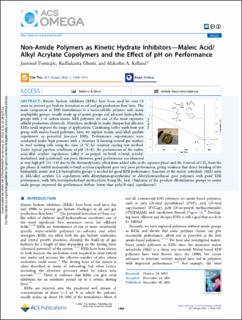| dc.contributor.author | Pomicpic, Janronel Calog | |
| dc.contributor.author | Ghosh, Radhakanta | |
| dc.contributor.author | Kelland, Malcolm Andrew | |
| dc.date.accessioned | 2023-02-17T12:18:09Z | |
| dc.date.available | 2023-02-17T12:18:09Z | |
| dc.date.created | 2022-01-20T08:37:05Z | |
| dc.date.issued | 2021 | |
| dc.identifier.citation | Pomicpic, J., Ghosh, R., & Kelland, M. A. (2021). Non-Amide Polymers as Kinetic Hydrate Inhibitors─ Maleic Acid/Alkyl Acrylate Copolymers and the Effect of pH on Performance. ACS omega, 7(1), 1404-1411. | en_US |
| dc.identifier.issn | 2470-1343 | |
| dc.identifier.uri | https://hdl.handle.net/11250/3051950 | |
| dc.description.abstract | Kinetic hydrate inhibitors (KHIs) have been used for over 25 years to prevent gas hydrate formation in oil and gas production flow lines. The main component in KHI formulations is a water-soluble polymer with many amphiphilic groups, usually made up of amide groups and adjacent hydrophobic groups with 3–6 carbon atoms. KHI polymers are one of the most expensive oilfield production chemicals. Therefore, methods to make cheaper but effective KHIs could improve the range of applications. Continuing earlier work from our group with maleic-based polymers, here, we explore maleic acid/alkyl acrylate copolymers as potential low-cost KHIs. Performance experiments were conducted under high pressure with a structure II-forming natural gas mixture in steel rocking cells using the slow (1 °C/h) constant cooling test method. Under typical pipeline conditions of pH (4–6), the performance of the maleic acid/alkyl acrylate copolymers (alkyl = iso-propyl, iso-butyl, n-butyl, tetrahydrofurfuryl, and cyclohexyl) was poor. However, good performance was observed at very high pH (13–14) due to the thermodynamic effect from added salts in the aqueous phase and the removal of CO2 from the gas phase. A methyl maleamide/n-butyl acrylate copolymer gave very poor performance, giving evidence that direct bonding of the hydrophilic amide and C4 hydrophobic groups is needed for good KHI performance. Reaction of the maleic anhydride (MA) units in MA/alkyl acrylate 1:1 copolymers with dibutylaminopropylamine or dibutylaminoethanol gave polymers with good KHI performance, with MA/tetrahydrofurfuryl methacrylate being the best. Oxidation of the pendant dibutylamino groups to amine oxide groups improved the performance further, better than poly(N-vinyl caprolactam). | en_US |
| dc.language.iso | eng | en_US |
| dc.publisher | American Chemical Society | en_US |
| dc.rights | Navngivelse 4.0 Internasjonal | * |
| dc.rights.uri | http://creativecommons.org/licenses/by/4.0/deed.no | * |
| dc.title | Non-Amide Polymers as Kinetic Hydrate Inhibitors-Maleic Acid/ Alkyl Acrylate Copolymers and the Effect of pH on Performance | en_US |
| dc.type | Peer reviewed | en_US |
| dc.type | Journal article | en_US |
| dc.description.version | publishedVersion | en_US |
| dc.rights.holder | The authors | en_US |
| dc.subject.nsi | VDP::Matematikk og Naturvitenskap: 400 | en_US |
| dc.source.pagenumber | 1404-1411 | en_US |
| dc.source.volume | 7 | en_US |
| dc.source.journal | ACS Omega | en_US |
| dc.identifier.doi | 10.1021/acsomega.1c06063 | |
| dc.identifier.cristin | 1985603 | |
| dc.relation.project | Norges forskningsråd: 308813 | en_US |
| cristin.ispublished | true | |
| cristin.fulltext | original | |
| cristin.qualitycode | 1 | |

